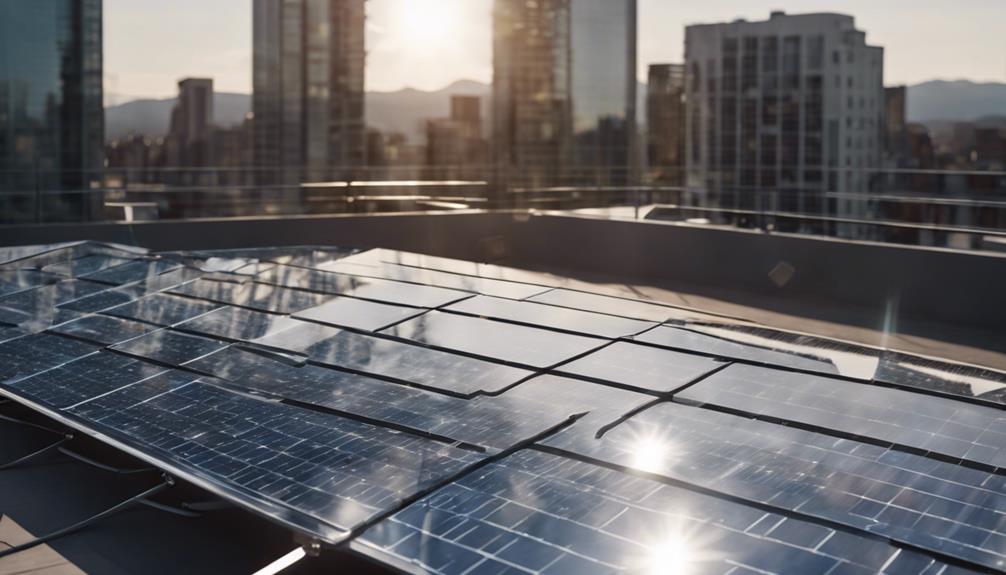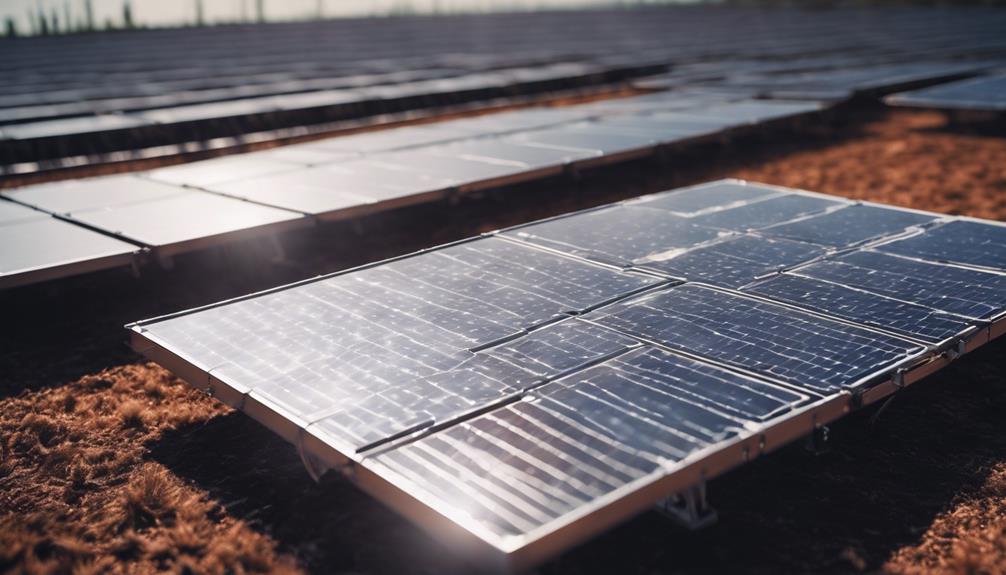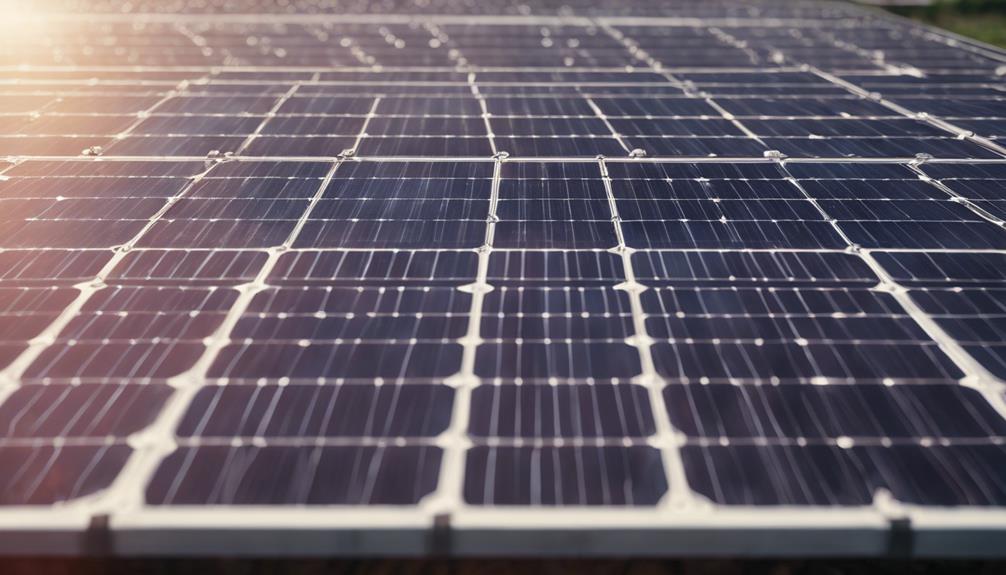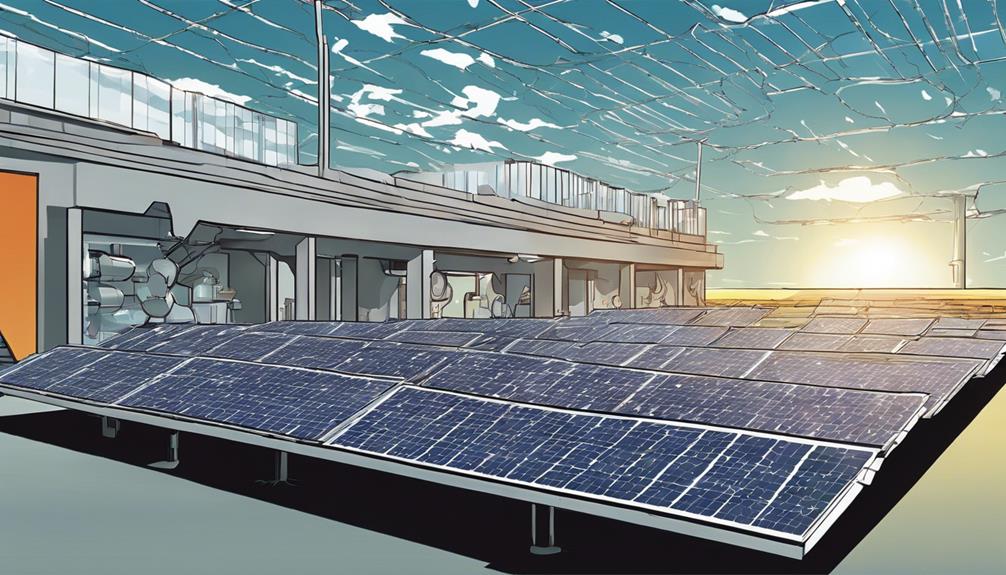You'll be thrilled to learn that solar cell efficiency has surged, boosting performance and slashing costs. With innovations in perovskite cells and bifacial panels, sustainable energy is at the forefront. Incredible advancements have made solar energy systems more efficient and affordable. These developments signal a bright future for solar power.
Key Takeaways
- Perovskite solar cells exceed 33% efficiency, surpassing traditional silicon.
- Bifacial panels increase yield by up to 30%, improving cost-effectiveness.
- Ongoing research focuses on stability and scalability of perovskite cells.
- Perovskite-silicon tandem cells offer enhanced performance and cost reduction.
- Advancements in perovskite technology drive efficiency gains and cost savings in solar energy.
Solar Panel Efficiency Rates Surge
Solar panel efficiency rates have surged in recent years, doubling from around 10% to over 20-25%. This increased efficiency translates to more electricity production from the same amount of sunlight, a significant advancement in renewable energy technology.
Not only does this higher efficiency benefit the environment by reducing carbon emissions, but it also has a direct impact on consumers. The lower costs associated with solar power due to enhanced efficiency make it a more accessible and cost-effective energy solution for households and businesses alike.
As efficiency rates continue to rise, the overall cost of solar energy systems decreases, further propelling the growth of the solar energy sector globally. The combination of increased efficiency and reduced costs has played a pivotal role in accelerating the adoption of solar energy technologies, paving the way for a more sustainable and environmentally friendly future.
Perovskite Solar Cell Innovations

With advancements in perovskite solar cell technology, high efficiency levels exceeding 20-25% have been achieved. Recent breakthroughs even pushed the efficiency boundaries to a world record of 26.41%.
Here are some key points to keep in mind regarding perovskite solar cell innovations:
- High Efficiency: Perovskite solar cells offer efficiency improvements that surpass traditional silicon panels, making them a promising alternative for renewable energy solutions.
- Cost-Effective: The cost-effectiveness of perovskite technology provides a competitive edge in the solar industry, offering a more affordable option for consumers looking to invest in sustainable energy sources.
- Ongoing Research: Researchers are focusing on enhancing the stability and scalability of perovskite cells to ensure long-term viability and widespread adoption in the market.
Perovskite-silicon tandem cells are also being explored to combine the strengths of both materials, leading to even greater performance enhancements.
These advancements in perovskite solar cell technology are paving the way for a more efficient and cost-effective solar energy future.
Bifacial Solar Panel Technology Advancements

Bifacial solar panel technology advancements have greatly boosted efficiency and cost-effectiveness. These panels now capture sunlight from both sides, increasing energy yield by up to 30%.
Recent improvements in technology have made bifacial panels a versatile and economically viable option for solar energy applications.
Bifacial Panel Efficiency
Enhancing the efficiency of solar panels, advancements in bifacial technology have revolutionized energy production capabilities. Bifacial solar panels are a game-changer in the renewable energy sector, offering increased energy yield and cost-effectiveness.
Here's why you should consider the efficiency of bifacial panels:
- Dual-Sided Sunlight Capture: Bifacial panels have the unique ability to harness sunlight from both the front and back surfaces, significantly boosting energy production by up to 30% compared to traditional panels.
- Improved Efficiency and Cost Reduction: Recent technological advancements haven't only enhanced the efficacy of bifacial panels but also led to cost reductions, making them a more attractive option for sustainable energy solutions.
- Versatility and Economic Viability: Bifacial panels are versatile and suitable for various applications, providing increased economic viability for both residential and commercial solar installations. Their adaptability and efficacy contribute to making solar energy solutions more efficient and visually appealing.
Cost-Effectiveness Advancements
Recent advancements in bifacial solar panel technology have notably enhanced cost-effectiveness in solar energy production. Bifacial panels, capable of capturing sunlight from both the front and back, have increased energy yield by up to 30%. This improvement translates to reduced costs for solar energy systems, making them a more attractive option for consumers looking to invest in renewable energy solutions.
One key benefit of bifacial panels is their versatility, allowing for various applications that enhance the economic viability of solar energy installations. The upfront cost of solar panels has been a noteworthy barrier for many, but with the advancements in bifacial technology, the overall cost-effectiveness of solar energy systems has improved notably.
Flexible and Lightweight Solar Panel Innovations

Advancements in materials and manufacturing techniques have led to the development of flexible and lightweight solar panels, transforming the renewable energy landscape. These innovations offer remarkable benefits, such as:
- Enhanced Portability: Flexible solar panels are easily transportable due to their lightweight nature, enabling energy generation in remote areas or during outdoor activities.
- Increased Efficiency: With advancements in materials, these panels can now generate more power-per-kilogram, surpassing the capabilities of traditional solar panels.
- Versatile Applications: The adaptability of lightweight solar panels allows for diverse installations, from curved surfaces on buildings to integration into clothing or backpacks for on-the-go charging solutions.
Notably, researchers at MIT have even developed ultralight fabric solar cells thinner than a human hair, highlighting the continuous drive towards maximizing efficiency and sustainability in solar energy technologies.
The rise of flexible and lightweight solar panels signifies a significant shift towards more efficient and versatile renewable energy solutions.
Role of Solar Panel Technology in Energy Transition

Flexible and lightweight solar panels have revolutionized the renewable energy landscape, demonstrating the pivotal role of solar panel technology in reshaping the energy sector.
Solar panel technology plays a critical role in driving the shift to renewable energy sources by offering advancements in efficiency, accessibility, and cost-effectiveness.
Innovations such as perovskite solar cells and bifacial panels are enhancing the performance of solar energy systems. Perovskite solar cells provide a promising alternative to traditional silicon panels, delivering increased efficiency and affordability.
Bifacial panels contribute significantly to boosting energy production and improving economic viability in the renewable energy sector.
Additionally, the development of flexible and lightweight solar panels is expanding the possibilities for solar energy applications, making it easier to integrate solar technology into various environments.
Embracing these advancements in solar panel technology is essential for accelerating the energy transformation towards more sustainable and environmentally friendly renewable energy sources.
Future Outlook for Solar Panel Technology

You can anticipate continued growth in solar energy with advancements in efficiency, manufacturing, and design. Trends in technology are poised to shape the future of solar panels, making them more accessible and cost-effective on a global scale.
Expect ongoing innovation in the industry, particularly with the potential of perovskite technology and the rise of bifacial panels to enhance energy production and economic viability.
Efficiency Enhancements Forecast
Projected advancements in solar panel efficiency are paving the way for a significant evolution in renewable energy technology.
The forecast for efficiency enhancements in solar panels includes:
- Perovskite Technology: This innovative technology shows great promise for boosting solar panel efficiency, potentially revolutionizing the industry and making solar energy more accessible.
- Bifacial Panels: The increasing adoption of bifacial panels is anticipated to drive higher energy production and improved economic viability. These panels capture sunlight from both sides, maximizing energy generation.
- Flexible and Lightweight Panels: The development of flexible and lightweight solar panels won't only enhance efficiency but also expand the range of applications for solar energy. This advancement opens up possibilities for integrating solar panels into a variety of surfaces and settings.
As technological advancements continue to drive efficiency enhancements and cost reductions, the future of solar panel technology looks bright, offering increased sustainability and energy independence.
Technology Trends Projection
Looking ahead, advancements in solar panel technology are poised to revolutionize the renewable energy landscape with increased efficiency and cost-effectiveness.
Technology trends in the solar industry are driving continuous improvements in efficiency and reductions in costs, making solar energy more accessible and widespread worldwide.
Innovations such as perovskite technology show promise for further enhancing solar panel efficiency, while bifacial panels are expected to capture a larger market share, leading to increased energy production in the renewable energy sector.
Additionally, the development of flexible and lightweight solar panels is opening up new possibilities for diverse installations and applications, pushing the boundaries of solar energy utilization.
These ongoing trends in solar panel technology are paving the way for a more sustainable future, where solar power plays a central role in meeting global energy needs efficiently and affordably.
Industry Innovation Expectations
The future of solar panel technology holds exciting prospects for industry innovation and advancements in efficiency. As the solar energy sector continues to evolve, here are some key expectations for industry innovation:
- Perovskite Advancements: Industry experts anticipate significant strides in perovskite technology, paving the way for even higher solar panel efficiency levels and cost reductions.
- Bifacial Panel Market Growth: The market share of bifacial panels is projected to expand, offering increased energy production capabilities and improved economic viability for solar installations.
- Flexible and Lightweight Solutions: Expectations are high for the development of more flexible and lightweight solar panels, opening up new possibilities for integrating solar energy into various applications with ease.
With ongoing research and innovations driving progress in the solar panel industry, these advancements are set to revolutionize the accessibility and widespread adoption of solar energy in the coming years.
Optimizing Renewable Energy With Energy Storage

Integrating energy storage systems with solar panels presents a promising solution for optimizing renewable energy production. Advanced battery technologies, such as lithium-ion and flow batteries, are being developed to enhance energy storage for solar power. These innovative systems offer higher energy density, longer lifespan, and improved charging capabilities, maximizing the efficiency of solar energy utilization.
Moreover, advancements in battery management systems play an essential role in controlling and optimizing energy storage for solar panels. These systems guarantee that energy is stored and distributed effectively, further increasing the overall performance of solar installations.
To promote the integration of solar panels with energy storage systems, favorable incentives and support programs are being rolled out in 2024. These initiatives aim to encourage the adoption of solar-plus-storage solutions, paving the way for a more sustainable and efficient renewable energy landscape.
Advances in Solar Panel Cell Technologies

To stay at the forefront of renewable energy advancements, exploring the latest developments in solar panel cell technologies is key. Innovations in this field are revolutionizing solar energy production.
Here are three cutting-edge advancements to keep an eye on:
- Perovskite Solar Cells: These cells have achieved lab efficiencies exceeding 33% while also improving stability and longevity, promising a more reliable and efficient solar energy solution.
- Tandem Solar Cells: By absorbing a broader solar spectrum, tandem solar cells are reaching efficiencies of over 33% in lab settings, showcasing the potential for increased energy generation from the same surface area.
- Thin-Film Solar Cells: Offering a lighter weight and increased flexibility, thin-film solar cells are providing 18 times more power per kilogram than conventional panels, making them an attractive option for various applications.
These advancements signify a promising future for solar energy efficiency, paving the way for more sustainable and cost-effective renewable energy solutions.
New Solar Panel Cell Materials & Technologies

Exploring the latest advancements in solar panel cell materials and technologies opens up exciting possibilities for enhancing solar energy efficiency. Researchers are delving into new materials like High-Performance Solar Absorbers, offering stability in various conditions and efficient light-to-electricity conversion, potentially reducing contamination costs.
Tin Zirconium Titanium Selenide Alloys show promise for tandem cells, absorbing the infrared spectrum and potentially increasing efficiencies. Additionally, the development of Flexible and Stretchable Solar Cells by KAIST guarantees maintained conversion efficiency even under deformation, providing versatility in solar energy applications.
Moreover, advancements in Perovskite Solar Cells have led to lab efficiencies surpassing 33%, with improved stability and durability. Active research on lead-free alternatives is ongoing to enhance the technology further.
Bifacial and Multijunction Solar Cells are also making strides, increasing energy production by up to 30% by stacking multiple layers to capture different light wavelengths. These innovations in materials and technologies are propelling solar energy towards higher efficiency and wider adoption.
Frequently Asked Questions
What Recent Advancements Have Been Made in Solar Panel Technology That Increase Efficiency and Affordability?
Recent advancements in solar panel technology have greatly increased efficiency and affordability. With improved efficiency above 20-25%, solar power is now more accessible. Innovations like perovskite cells and bifacial panels drive progress, offering cost-effective solutions for renewable energy.
What Is the Efficiency Improvement of Solar Cells?
You know how upgrading your phone's operating system boosts performance? Solar cells have done the same – efficiency levels jumped from 10% to 20-25%. This means more electricity from sunlight, lowering costs for you.
How Has the Efficiency of Solar Panels Improved Over Time?
Solar panels have improved greatly over the years, increasing efficiency from 10% to 20-25%. This means more electricity with the same sunlight. Costs have decreased, making solar energy more accessible and appealing.
How Can We Reduce the Cost of Solar Energy?
To reduce the cost of solar energy, you can leverage advanced manufacturing techniques, scale economies, and innovative materials like perovskite cells. Simplifying installation, enhancing system integration, and taking advantage of incentives and financing options also play significant roles in cost reduction.
How Do Advancements in Solar Cell Efficiency Impact Solar Farm Design?
Advancements in solar cell efficiency have a significant impact on definitive solar farm design best practices. With higher efficiency, solar farms can generate more power in a smaller footprint, allowing for better utilization of available space. This can lead to improved design strategies for maximizing energy production and overall performance.
Conclusion
As you gaze upon the horizon, envision a world where solar panel efficiency rates surge, perovskite solar cell innovations shine bright, and bifacial solar panel technology leads the way.
Imagine a future where flexible and lightweight solar panel advancements pave the path for a sustainable energy metamorphosis.
Embrace the role of solar panel technology in optimizing renewable energy with energy storage.
With new materials and technologies on the horizon, the future of solar power is as bright as the sun itself.










